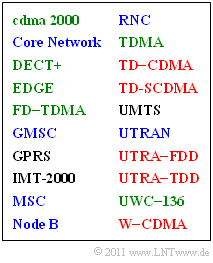Difference between revisions of "Aufgaben:Exercise 3.6Z: Concepts of 3G Mobile Communications Systems"
| Line 65: | Line 65: | ||
- the "Base Station" (for UMTS: "Node B"), | - the "Base Station" (for UMTS: "Node B"), | ||
+ the "Radio Network Controller" (RNC), | + the "Radio Network Controller" (RNC), | ||
| − | + | - the "UMTS Terrestrial Radio Access Network" (UTRAN). | |
</quiz> | </quiz> | ||
Revision as of 18:59, 24 January 2021
On the right there are various terms used in 3G mobile communications systems.
Third generation systems include, for example, the following standards:
- $\text{IMT–2000}$: This abbreviation stands for $\rm I\hspace{-0.01cm}$nternational $\hspace{0.05cm}\rm M\hspace{-0.01cm}$obile $\hspace{0.05cm}\rm T\hspace{-0.01cm}$elecommunications at the year $2000$;
- $\text{UMTS}$: $\rm U\hspace{-0.01cm}$niversal $\rm M\hspace{-0.01cm}$obile $\rm T\hspace{-0.03cm}$elecommunication $\rm S\hspace{-0.01cm}$ystem.
Only one of the twenty listed terms is out of the ordinary. This is a system extension of $\rm GSM$.
Notes:
- This task refers to the chapter Characteristics of UMTS.
- Reference is also made to the main chapter UMTS of the book "Examples of Communication Systems".
Fragebogen
Musterlösung
(1) Richtig ist die Aussage 2:
- Der IMT–2000–Standard beinhaltet in einer ersten Ebene W–CDMA, TD–CDMA, TDMA und FD–TDMA, wobei nur die beiden zuerst genannten Varianten gleichzeitig dem UMTS–Standard zugerechnet werden.
- Daraus folgt: UMTS ist eine Untermenge von IMT–2000, nicht umgekehrt.
(2) Alle zu UMTS gehörigen Eintragungen sind in der Tabelle rot markiert ⇒ Antwort 1:
Zu W–CDMA zählt man
- UTRA–FDD, die FDD–Komponente des europäischen UMTS–Standards,
- das amerikanische cdma 2000–System, das aber nicht zu UMTS gehört.
Zu TD–CDMA werden hinzugerechnet:
- UTRA–TDD, die TDD–Komponente von UMTS,
- das chinesische TD–SCDMA, mittlerweile in den UMTS–TDD–Standard integriert.
(3) Richtig ist der zweite Lösungsvorschlag:
Die drei Systemvarianten, die zwar zu IMT–2000 gehören, aber nicht zu UMTS, sind:
- TDMA: Hierzu zählen Weiterentwicklungen des GSM–Ablegers EDGE und des amerikanischen Pendants UWC–136,
- FD–TDMA, die Weiterentwicklung des Schnurlos–Telefonie–Standards DECT,
- der amerikanische Standard cdma 2000}.
(4) Richtig sind die Antworten 1, 4 und 6, wie man im Buch „Beispiele von Nachrichtensystemen” , Kapitel UMTS–Netzarchitektur nachlesen kann.
(5) Aus obigem Link geht auch hervor, dass hier die Antworten 2, 3 und 5 zutreffen.
Übrigens:
Der einzige Begriff in der Grafik auf der Angabenseite, der sich nicht auf UMTS bezieht, ist „GPRS” ⇒ General Packet Radio Service ist eine GSM–Erweiterung.
